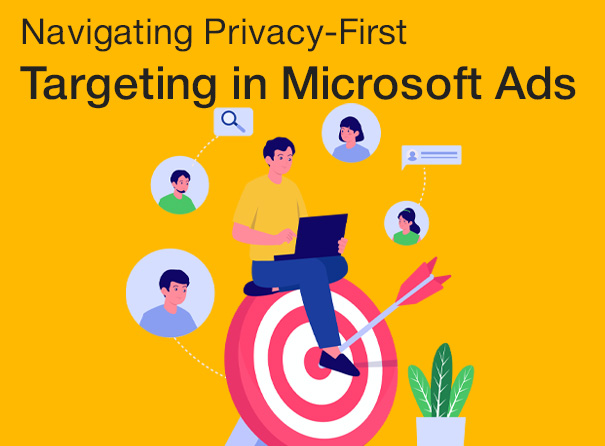Table of Contents
- Introduction
- Why Privacy-First Targeting Matters
- First-Party Data Targeting in Microsoft Ads
- Contextual Targeting in Microsoft Ads
- Combining First-Party & Contextual Strategies
- Final Thoughts

Table of Contents

TL;DR: - As cookies disappear and privacy rules become stricter, advertisers must find new ways to connect with audiences without intrusive tracking. Microsoft Ads is at the forefront with first-party data targeting, which uses customer information like emails, purchase history, and remarketing lists. It also offers contextual targeting, which shows ads based on the content users are viewing. The real power comes when these two methods are combined. First-party data ensures ads are personalized and allows for remarketing, while contextual targeting offers brand safety and relevance. Together, these approaches enable advertisers to run privacy-focused campaigns without losing effectiveness.
The advertising world is undergoing a significant change regarding privacy. With cookies diminishing and regulations becoming stricter, brands can no longer track users across the internet as they once did. The new approach emphasizes building trust while keeping campaigns effective. Microsoft Ads is at the forefront, offering privacy-first targeting strategies that rely on first-party and contextual audiences. At Inqnest, we understand how daunting this transition can be. However, there’s good news: prioritizing privacy doesn’t mean sacrificing performance. By using the right mix of targeting strategies, you can strengthen customer relationships and run smarter campaigns. If you’re looking for ways to navigate this shift, our Paid Advertising Agency services can help you drive growth in a privacy-first landscape.
Privacy-first targeting represents the new rules of engagement in digital advertising. Users are becoming more aware of their data rights, regulations are tightening, and major tech companies are moving away from third-party cookies. Relying on outdated tactics could lead to ads that lack both reach and relevance.
Microsoft Ads anticipated this change and developed solutions that respect user privacy without compromising performance. The platform now helps advertisers use first-party data (your brand’s customer information) and contextual signals (relevance based on content rather than personal tracking). Together, these elements create a targeting approach that is respectful, precise, and effective.
Your first-party data is incredibly valuable in this privacy-first era. It’s clean, based on consent, and directly connected to your brand. Microsoft Ads makes it easy to leverage this data, helping you reach audiences most likely to engage.
If Microsoft Ads is your playground, first-party data is your ticket to success. Managing it well requires a solid strategy. Many brands struggle with transforming raw customer insights into segmented campaigns that convert. If this is something you’re facing, check out our blog on Bing PPC Advertising Services to see how first-party tactics can enhance your Microsoft Ads ROI.
Next, let’s discuss contextual targeting. Instead of tracking users, you place ads based on the content they are currently viewing. This method is relevant, timely, and respects user privacy.
Microsoft Ads has improved beyond basic keyword matching. Using AI-powered contextual analysis, the platform understands webpage content, categories, and even sentiment. This means your ad is more likely to appear in front of users when they are already in the right mindset.
The advantage of contextual targeting is that it merges brand safety with relevance. When you think even bigger, such as with programmatic campaigns, it gets even more exciting. Our blog on Programmatic Advertising Services explores how contextual strategies can scale effectively across CTV, DOOH, and video.
The true potential emerges when you combine these two approaches. First-party data and contextual targeting are not competitors; they work together.
Here’s how to make them work in harmony:
When executed well, this strategy ensures you’re not just reaching people but connecting with the right people at the right time with the right messages.
Final Thoughts
Transitioning to a privacy-first advertising landscape does not entail losing targeting precision. It means working smarter. The combination of first-party data and contextual audiences in Microsoft Ads provides advertisers with the tools to maintain effectiveness while respecting user privacy.
At Inqnest, we assist brands in connecting data, creativity, and strategy. Embracing privacy-first targeting is the future, and brands that adapt early will gain a competitive advantage.
If you’re curious about how this fits into your campaigns, let’s chat.
It’s a strategy that delivers ads without tracking users across the web using third-party cookies. Instead, it relies on first-party data and contextual relevance to maintain performance while respecting privacy.
First-party data comes directly from your customers, such as emails, purchase history, and site interactions. It is consent-based, accurate, and prepared for a world without cookies.
Contextual targeting places ads on pages based on keywords, topic categories, and sentiment analysis. This ensures that ads appear in the right content environment without tracking personal data.
Yes! For example, you can use contextual targeting for top-of-funnel awareness and first-party remarketing for conversions. Together, they create a complete, privacy-safe campaign.
Not at all. With Microsoft Ads’ AI-driven contextual tools and first-party integrations, advertisers can achieve both precision and compliance. This often leads to improved customer trust and return on investment.








